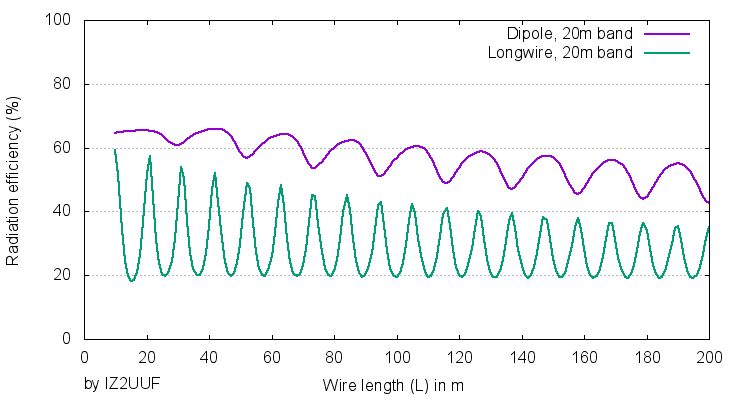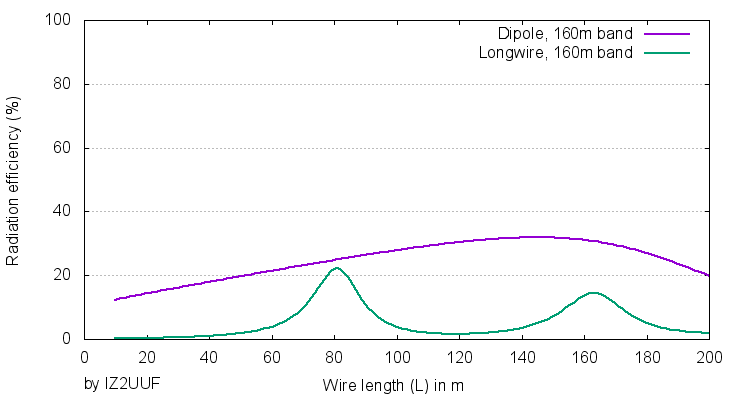
One of the most tempting all-band cheap antenna solution when a lot of space is available is the “long wire”. The idea is to lay a wire as long as possible and to feed it at one of its ends, while the other pole is grounded. Some kind of fixed impedance transformer plus maybe a tuner will make this antenna work all bands.
But, is the long-wire the best way to take advantage of space availability? Is “the longer, the better” true?
With this kind of antenna, lobe shapes in the various bands are out of control: too many local factors, forced paths and nearby objects condition them in real world installations. Therefore, I decided to investigate this issue under the point of view of radiation efficiency. Knowing that I can hardly control lobes direction in higher bands and having NVIS effect from 40m downwards due to the low height of the wire, I wanted to know which was the solution that allowed me to put on-air as much RF as possibile.
The NEC simulator is able to calculate the actual radiated power taking in account the interactions with ground. Assuming a perfect condition, i.e. a flat, empty and uniformly lossy ground, I wanted to see which was the wire configuration that potentially guarateed the maximum amount of delivered power.
I simulated a end-fed wire laid horizontally at 10m height. I simulated various lengths “L” ranging from 10m to 200m at steps of 1m in the bands of 10, 20, 40, 80 and 160m.
The calculations did not take in account the losses due to impedance adaption and transmission lines. They just considered the power that actually is fed into the antenna wires and report the percentage of it that is actually radiated. The rest goes into warming the wires themselves and the surrounding ground.
The idea is not to have exact figures to be applied in real cases, but to find indications useful to better exploit the available local conditions.
The longwire
This simulation involves a long-wire of length “L” with the configuration below:

The graph below shows the radiation efficiency of the longwire in the tested bands vs. wire length.

Two things appear immediately when reading this graph:
- the efficiency is good only when length is a multiple of 1/2 wavelength; at the other lengths, the efficiency drops dramatically; at the lowest bands, it can reach values as low as 1%;
- it is not true that “the longer, the better”: radiation efficiency tends to drop when the wire becomes longer;
The random dipole
Another possibile configuration is the random dipole. The same amount of wire used by the long wire main radiator is split and fed at its center.

This is the behaviour of the random dipole, obviously at the exactly same testing conditions of the previous long wire:

As we can see, the dipole efficiency does not variate as badly as it does with the long-wire. Whatever length is chosen, it will be a fairly good one on every band.
Longwire vs. dipole
It is interesting to directly compare a dipole with a longwire on each band.





By reading these graphs we can see that symmetric center fed dipole is always more efficient than an end-fed wire. In lower bands, like for example in the 160m band, the long-wire is badly inefficient (1%…5%) except at some precise lengths (1/2 and 1 wavelength). Instead, the dipole shows a consistent and much higher efficiency no matter what length has been chosen. And this happens on every band.
Conclusions
With this analysis I had a numeric feedback which was consistent to my experience: I never found an end-fed antenna that, laid side by side, could return better signals than a center fed dipole of comparable size. Results were ranging always from “a little less” to “a lot less”, which is exactly what it should be expected after this numeric investigation.
Besides of efficiency, balanced dipoles do not pick up common mode generated noise, which makes them much more silent antennae.
So my conclusions are:
- spend any effort to lay two wires in a dipole-shape rather than a single one: it is always worth; they can be fed with two parallel wires directly into a balanced tuner or in a 1:1 balun and then in a unbalanced tuner with little loss, no glowing toroids, no coax;
- if end-fed is the only option, go for EFHWA (End Fed Half Wave Antenna): it won’t work on odd bands, but at least at 10, 20, 40, 80 and 160m efficiency will be reasonable.
- do not exaggerate with the length of the wires: once they reached their optimum, the longer they grow, the lower is the radiation efficiency.


Grazie per l’interessantissimo paragone (mi si perdoni l’italiano). Però non si capisce il motivo per cui il dipolo risulta più efficiente della long wire. Credo che un filo, se adeguatamente alimentato, irradi tutta l’energia che gli viene immessa (tolte le perdite ohmiche), quindi la differenza dovrebbe ricercarsi nel braccio di terra della long wire, che indubbiamente presenta maggiori perdite ohmiche rispetto ad una delle due braccia del dipolo.
Leggendo Moxon, questi suggerisce spesso radiali anche caricati, ma disaccoppiati con la terra, proprio per concentrare il ritorno di corrente sui radiali anzichè sulla terra che ha maggiori perdite, quindi probabilmente la differenza è proprio da ricercarsi nel braccio di terra della long wire.
73 de Rosario IK3OCA
Interesting matter.
I partially agree with Rosario. I would like to know if in the simulation software is it possible to insert the soil conductivity, I mean the ground quality. I think it is all there. And, to my mind, the ground quality of the top Davide’s picture is awful. One single wire 10 meters long is almost no ground at all for RF. It would be fine for DC, but not for RF. You can have the best soil conductivity on the Earth beneath the antenna wire, but if you reach it with a single wire 10 meters long you invalidate all the system. If the software took this into account, I am not surprised of the results.
Davide, do you think is it possible to make another software comparison using the same space but in inverted L configuration, so total antenna wire length L + 10 meters and a good ground or at least a net of radials?
As for Rosario, the poorer the ground the more radiation you lose in it. The extreme is to have just one radial of the same length of the antenna wire (I mean the hot side). You just rise the radial to separate it from the ground and you obtain a dipole. Am I right?
Thanks.
Claudio
You are really knocking it out of the park Rosario! Bravo to some science being applied to these questions. You mentioned noise on a long wire vrs a dipole of the same length. I found the folded dipole to be better (Just my impression) versus a dipole of the same length. I wonder if you could model that with your software to see how well it radiates? 73 de W0VNE
Excellent informative article, thank you for your research and for making it available to us.